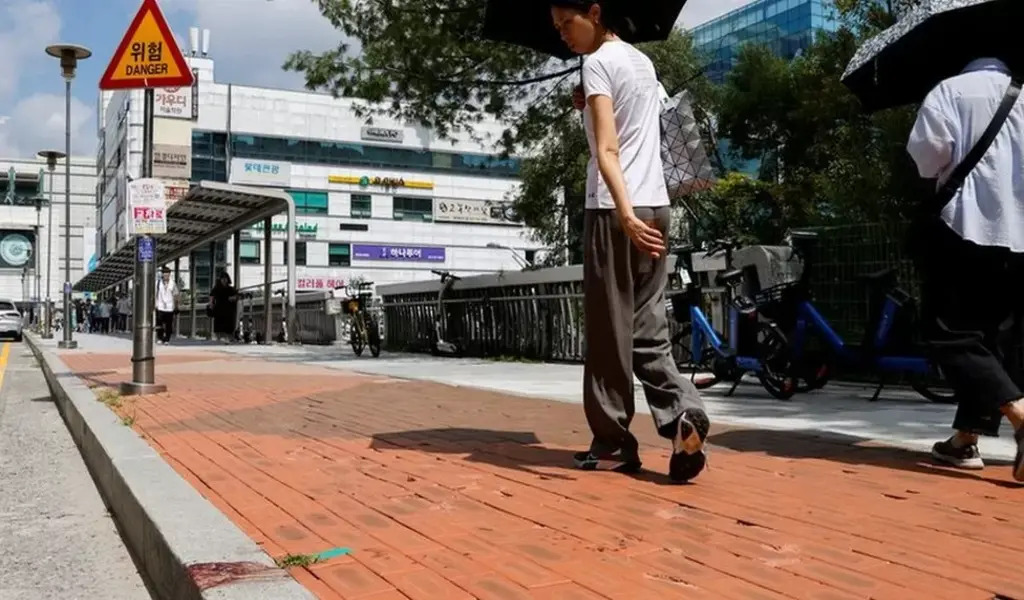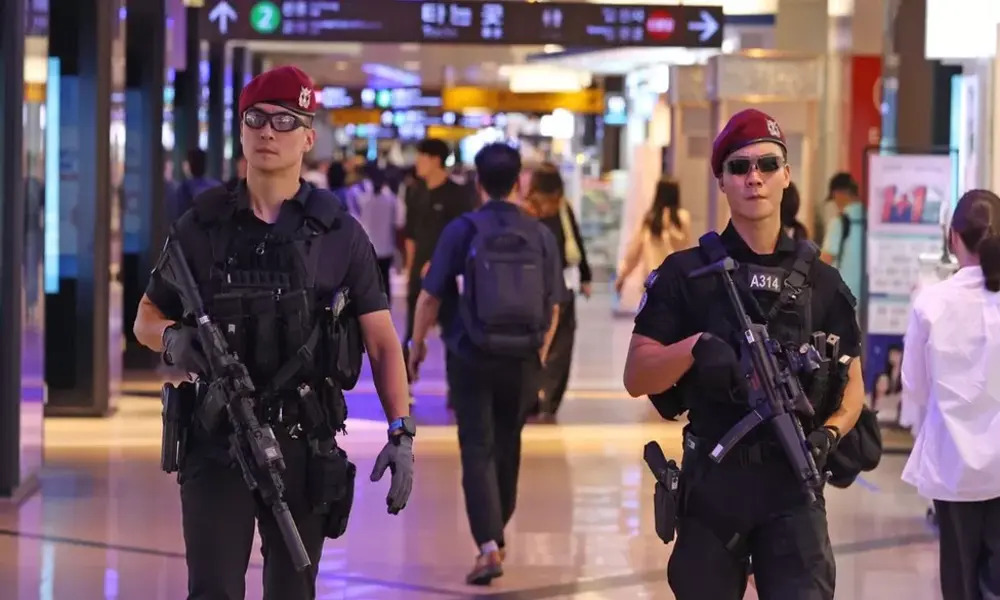(CTN NEWS) – A chilling scene unfolded within a crowded subway car as a knife swiftly emerged, sending shivers down the spines of onlookers. A malefactor, in hot pursuit of innocent shoppers, unleashed a frenzy of wild stabbings on a bustling street.
These harrowing nightmares have haunted the thoughts of numerous South Koreans in the wake of a recent spate of mass stabbing incidents – the second such occurrence in as many weeks for the country.
On August 3rd, in Seongnam, situated to the southeast of Seoul, the tranquility was shattered as a man plowed his car into pedestrians near a subway station, then bolted into a department store. Inside, he proceeded to wield his blade, leaving nine individuals wounded and tragically claiming the life of a woman who succumbed to her injuries later.
In the aftermath, bewildered citizens took to the online sphere, their voices a mix of distress and astonishment, questioning the state of affairs in South Korea.
Accustomed to a reputation for minimal violent crime, they grappled with the recent back-to-back stabbings that seemed to defy their nation’s prevailing image of safety.
“Once hailed as one of the world’s safest havens, what has befallen South Korea?” wondered one individual in a YouTube comment, articulating the collective sentiment.
Echoes of Disturbing Inspiration: Unraveling the Connection Between Consecutive Attacks in South Korea
Merely days before, on July 21st, a separate assailant had launched an attack on commuters within the capital city, claiming the life of one person and inflicting stab wounds upon three others at a subway station.
Subsequent police interviews revealed his motive – a desire to share his misery by inflicting it upon others.
Evidently, the second attacker took inspiration from his predecessor’s actions, as later findings would indicate.
The suspect, a 22-year-old named Choi Won-jong, had a history marked by struggles.
A delivery driver and a high-school dropout diagnosed with schizoid personality disorder, he had actively sought information about the initial assault at Sillim Station, suggesting a disturbing semblance of emulation.
These unnerving incidents have left a nation grappling with the unexpected, redefining their perception of security and prompting introspection into the roots of these unsettling events.
Navigating the Enigma of “Don’t Ask Why” Crimes in South Korea: Unraveling Motives Amidst Rising Concerns
In South Korea, a perplexing phenomenon known as “Don’t Ask Why” or Mudjima crimes has emerged – instances of unexplainable violence directed at strangers, devoid of any apparent personal connection to the victims or discernible motives.
While the public had been using the term Mudjima for years, it wasn’t until 2022 that South Korean law enforcement officially categorized such acts as a distinct type: “Abnormal Motive Crimes”.
With clear definitions established and a dedicated task force established to combat these crimes, this move seemed to signify a newfound seriousness on the part of authorities. In the first half of the current year, 18 Mudjima incidents were documented by the police.
Despite general statistics indicating no surge in violent crime – in fact, South Korea registered its lowest rates in a decade last year – the recent spate of stabbings has fostered a perception that Mudjima occurrences are more frequent, rendering society seemingly more perilous.
This perception has even fueled some individuals to draw parallels with the United States, leading to online commentary such as: “The American mentality is spreading in South Korea” and “OMG, South Korea is becoming the USA of Asia.”
Nevertheless, experts maintain that South Korea remains a remarkably secure nation.
“Comparatively, homicide and other forms of violent crime are exceedingly rare, both in historical context and relative to other countries. The trend has been a consistent decline over the past decade,” stated Professor Hyojong Song, a criminology authority at Korea University in Seoul.
South Korea’s homicide rate, resting at 1.3 murders per 100,000 individuals, stands at half the average of OECD nations and less than a fifth of America’s homicide rate. Moreover, stringent gun control measures are in place.
Many online voices argued that the oversimplified comparisons with the US obfuscate the genuine need for local authorities to address the underlying social issues contributing to these incidents:
“It’s imperative to examine South Korea’s unique social challenges that have contributed to this situation,” penned one user.
As details about the perpetrators remain vague, the limited information disclosed thus far has already ignited public conjecture and ire.
“In this era, we’re witnessing unemployed individuals venting their frustrations on innocent people,” one TikTok user commented, reflecting a prevailing sentiment observed across various online platforms.
Similarly, a commenter on YouTube contended, “In the past, only individuals with psychopathic tendencies would engage in such acts, but nowadays, we find ourselves in a world where ordinary people are turning into perpetrators of violence.
The lack of hope, heightened anxiety, and diminished sense of happiness are prevailing.”
Experts have shed light on the underlying societal pressures within South Korea, ranging from precarious job prospects and housing insecurity to enduring stigmas related to mental well-being and a deficiency of support services.
Authorities revealed that Choi had not received adequate treatment.
“In essence, I believe that we urgently require emotionally and practically oriented social support systems or policies that can aid those who feel detached from society, lacking social connections,” Professor Song emphasized during an interview with the BBC.
Amidst Stabbing Fears, Online Threats Fuel Public Unease and Vigilance
What exacerbated ongoing public apprehension following the stabbing incident last week was the surge of menacing threats that emerged, promising imitative attacks.
These online declarations delineated precise timings and locations, some even specifying the gender of intended victims to be targeted. Alarming words such as “kill as many people as possible” echoed through these posts.
While some brushed aside these declarations as the antics of adolescents and attention-seekers, they undeniably succeeded in rattling the populace.
Across social media platforms, vigilant users disseminated alerts for the weekend spanning August 4th to 6th. One TikTok video, garnering over 300,000 views across Asia, bore the message: “Please steer clear of these South Korean areas.”
The host, a North American expatriate residing in Seoul, shared a list of prospective stabbing locations, including several subway stations, nightlife districts, an amusement park, and a women’s university stop.
“Feel free to capture this screenshot – here’s a compilation of potential public stabbing sites for the weekend,” the host stated in the video, coupled with words of caution: “Remain vigilant, stay aware of your surroundings, and prioritize your safety out there.”
In response, the police initiated a “special enforcement” operation for the designated weekend, deploying a considerable augmentation of officers to public locales.
These law enforcement personnel were tasked with halting and inspecting individuals appearing “suspicious” – a measure that led to at least one arrest after an individual was spotted carrying knives in a public setting.
Cracking Down on Online Threats and Responding to Apprehensions
Authorities also took decisive action against the online threats, diligently tracking individuals throughout the nation by tracing their internet service addresses and acting upon tip-offs.
In the aftermath of the weekend operation, law enforcement divulged that they had pinpointed nearly 200 threats and taken approximately 60 individuals into custody.
Notably, 34 of these apprehended individuals were teenagers, with several being 14 years old or younger and thus exempt from criminal prosecution.
Among the detained, a 17-year-old boy found himself in custody for issuing a stabbing threat at a train station in Wonju, only to subsequently report the threat to the police under the guise of a tip-off.
In a separate incident, a 14-year-old was arrested near the subway station he had identified as a target. When questioned, he informed authorities that he had no intention of committing murder; his motive for the online post was mere boredom, and he had shared it as a jest.
As successive days unfold without further incidents, some of the immediate tension gripping the public begins to wane. Yet, a sense of apprehension continues to linger in the minds of many.
An increasing number of individuals have opted to carry protective items like mace sprays, and within crowded places such as subway platforms, vigilance is palpable as people remain watchful of their surroundings and those nearby.
Just this past Saturday, exuberant fans aboard a night train returning from a concert featuring a member of BTS inadvertently triggered a near stampede.
Developments and Responses in the Wake of Recent Terrifying Incidents
The jubilant cries of these fans were misconstrued as terror, prompting passengers to flee. Those who fled later likened their experience to scenes from a zombie film.
A newly established web service designed to map online threats reportedly amassed over 50,000 views within its initial days of operation, as per local media reports. This platform continues to document new threats on a daily basis.
Korean media disclosed on Wednesday that police managed to identify the originator of an online threat a mere eight minutes after its dissemination.
These “acts of terror” have kindled discourse within the political sphere, prompting discussions on bolstering measures against crime.
In the past week, legislators have pledged to institute more stringent penalties for mass stabbings, lower the age of criminal responsibility, and amend legislation to legitimize assertive police interventions.
On Monday, the nation’s justice minister expressed the viewpoint that police use of force should be perceived as an act of self-defense.
An editorial featured this week in the Korean Herald succinctly encapsulated the sentiments of many: “The perpetration of such violent crimes in a nation renowned for its relatively high levels of public safety is profoundly shocking.
“A comprehensive inquiry to unearth the specific motives behind these horrifying crimes is imperative. Concurrently, the police must implement measures to forestall the emergence of imitative offenses.”
RELATED CTN NEWS:
U Visa: How A Visa Program Meant To Assist Law Enforcement Puts Immigrant Victims At Risk
Tragic Consequences: Heavy Rainfall Spurs Evacuations And Fatal Mudslide in China’s Southwest
Saudi Arabia’s Vigorous Bid To Join GCAP: Alliance Tensions And Prospective Contributions









